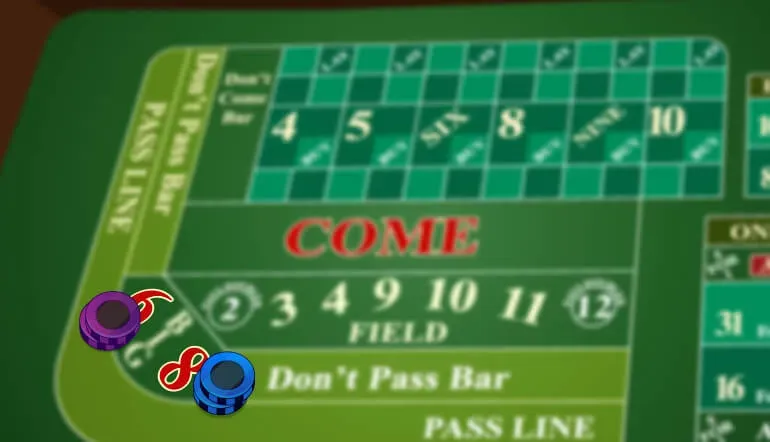Craps gives you one of the best shots to win among casino games.
When betting pass plus odds or don’t pass plus free odds, the house edge can be measured in tenths of a percent. Even if you don’t bet the odds, casino games offer few better deals than the 1.4 percent house edge on don’t pass or don’t come, 1.41 percent on pass or come, or 1.52 percent when placing 6 or 8.
The best craps strategies focus on the bets with the lowest house edges.
You can safely ignore one-roll bets with high edges to the house such as any 7 (16.67 percent) or any craps (11.11 percent). You also can ignore the multiroll hardway bets (9.09 percent on hard 6 or 8, 11.11 percent on hard 4 or 10) and the place bets on 4 or 10 (6.67 percent) and 5 or 9 (4 percent).
Combination bets such as the Iron Cross and hedge bets such as combining place 6 and 8 with any 7 don’t help you. The house edge of any combination is a weighted average of the component bets, and the high-house edge portions of combinations undermine your chances to win overall.

Which wagering system you should use depends on your temperament and bankroll. If you can’t stand being alone on the don’t side while other players cheer for the shooter, then don’t pass and don’t come aren’t for you despite the low edge.
And if you’re short of bankroll, then systems that call for you to make multiple odds wagers are not for you. You could lose too large a share of your stake on a single roll of the dice.
With that in mind, these craps strategies will give you the best shot to win by staying on the bets with the lowest house edges.
DON’T PASS AND DON’T COME PLUS LAY THE ODDS
This will never be the most popular strategy because most players like the camaraderie of betting with the shooter.
But don’t pass and don’t come coupled with laying the odds gives you the lowest house edge among common wagers in the game of craps.
Lay odds are paid at true odds, meaning there is no house edge on that portion of a wager. The house edge for don’t pass or don’t come with lay odds is a weighted average of the 1.4 percent edge on the don’t bet and the zero edge on the odds.
With the common 3x, 4x, 5x odds, the craps house edge on the combination drops all the way to 0.2 percent.
The key is to keep your don’t pass and don’t come bets to a minimum, and to put the remainder of your normal-size wager into laying the odds. With that method, you expose the least money to the house edge on the don’ts, while saving most of your bet for the no-edge odds.
Most craps players like to have more than one number working. In this system, that’s accomplished by following up don’t pass wagers with don’t come wagers, and backing both with available odds.
You’d start with a don’t pass wager. When the shooter establishes a point, lay the odds, then make a don’t come bet. Once the shooter establishes a point for your don’t come bet, lay odds on that and make another don’t come bet, then lay the odds again in turn.
That gives you up to three numbers working at once, all with minimum don’t bets backed with odds.
If the shooter sevens out, all your don’t pass and don’t come bets win. If he makes any of the pass or come points, then you lose on that specific bet and you can follow up with a don’t bet to increase your working numbers back to three.
NOTE: For the short-bankrolled, there is nothing wrong with betting don’t pass, laying the odds and stopping there.
The house edge is the same regardless of how many numbers you have working. Most players find it more exciting to have more action, but it’s always important to avoid overbetting your bankroll.
PASS AND COME PLUS ODDS
This is a favored method for a large number of players because the house edge is very low and it involves betting with shooter. The “win together” feel of a hot craps table can be really special.
The method parallels that of the don’ pass / don’t come method. Start with a minimum bet on pass. When the shooter establishes a point, back your pass bet with free odds and follow with a come bet. Once there’s a point number for the come, back it with odds, then make a second come bet and take odds there, too.
With the common 3x, 4x, 5x odds, the house edge on the pass plus odds and come plus odds combination is 0.37 percent.
If your bankroll can’t handle full odds but you still want to take advantage of the no-edge odds bet, you can take as little as 1x odds, just matching your initial wager with free odds.
House edges are 0.85 percent with 1x odds, 0.61 with 2x odds, 0.47 with 3x, 0.33 with 5x, 0.18 with 10x, 0.10 with 20x and 0.02 with 100x.
Keep your pass and come bets low and put the remainder of your intended total into the odds.
Here’s an example of why: If you bet $25 on pass or come without odds, then per 100 decisions you have a total risk of $2,500 and an average loss expectation of $35.25.
But if you reduce your pass and come bets to $5 and put the remainder of you wagers in odds, your risk on pass and come is only $500 per 100 decisions, with an average loss of $7.05. With no house edge, the average expectation on the odds is to break even.
Your average loss is lower when you shift money from pass or come into odds, and you can have a winning sessions at craps with results that aren’t as far above the norm as you’d need with the larger pass and come bets.
PASS, FOLLOWED BY PLACE BETS ON 6 AND 8
Place bets on 6 and 8 join pass, don’t pass, come, don’t come and the craps odds as common wagers with out edges of less than 2 percent.
The house edge of 1.52 percent isn’t quite as good as the others, and since there is no comeout for these bets, it takes fewer rolls to decide them than pass, don’t pass, come or don’t come.
You can’t back place bets with free odds. You make your bet, and if the shooter rolls your number before a 7 you win, and if a 7 comes first, you lose.
Players like to place 6 and 8 because it puts them on the most commonly rolled numbers other than 7. With the other good bets, you take a chance of the comeout putting on less commonly rolled points – of 36 possible rolls, there are only three was to make 4, three to make 10, four to make 5 and four to make 9, compared with five each for 6 and 8.
The method is to start with a pass line bet. When the shooter establishes a point, it’s up to you and your bankroll whether to back with odds. Regardless, your next move is to make the place bets. If the point is 6, then place 8; if it’s 8, then place 6; if it’s neither, place booth.
Be sure to make your bets on 6 and 8 in multiples of $6. Winners on those place bets are paid at 7-6 odds, but the dealer won’t make change. A $5 bet will pay only $5, but a $6 winner will pay $7.
Players with modest bankrolls like this system because it requires less money up front than three working numbers all backed with odds. If you bet $5 on pass and $6 each on 6 and 8, your total wager is $17. If you bet $5 each on pass and two comes and add in another $15, $20 or $25 per wager in 3x, 4x, 5x odds, the maximum possible outlay is $85 and the minimum is $65.
The house edges of 1.41 percent on pass and 1.52 percent on placing 6 and 8 aren’t as strong as the 0.37 on pass, come and 3x, 4x, 5x odds, but it requires less money on the table.
PLACING 6 AND 8
Some players like to trust in the most commonly rolled non-7s and skip the pass and come bets entirely. This can be an inexpensive system if you make minimum bets on both. The house edge is 1.52 percent,

PASS AND COME OR DON’T PASS AND DON’T COME WITHOUT THE ODDS
This is a low-roller system that can put you on multiple numbers and give you some of the excitement of the top two strategies.
However, without the odds, you can’t reduce the house edge below the standard 1.4 percent on don’t pass and don’t come or 1.4 percent on pass and come.
Keep all your bets at the table minimum. If you’re tempted to raise your wagers, consider putting the extra money in odds instead.
However, for short-bankrolled players who hit their limits at table minimums, this is a viable low-cost, low-edge strategy.


